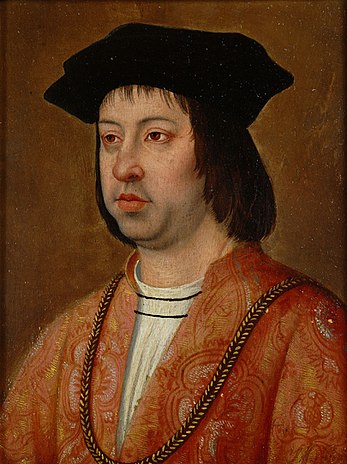
In the Tudorverse, Ferdinand of Aragon’s importance stems from his being the father of Henry VIII’s first wife, Catherine of Aragon – so my focus here is on how his death affected Catherine…. which was somewhat mixed. For Catherine personally, the loss of her father was devastating. For Catherine politically, the outcome was less clear: Ferdinand’s successor was Charles V – who would become Catherine’s greatest champion, and Mary’s after that. Quite the difference from Ferdinand himself, who used his daughter too many times – harming her relationship with her husband in the process.
Ferdinand was most notable for the couple he made with his wife, for being half of the “Ferdinand and Isabella” who transformed Spain in extreme ways that still trouble us today (we mourn the thousands they murdered in the Inquisition, we look askance at Columbus for the way he treated the inhabitants of the countries he claimed for Spain…). After Isabella died in 1504, Spain became technically no longer a single country since her realm of Castille passed to their daughter, Joanna (married to Philip I); this left Ferdinand only with his own Aragon, with much of his power gone. To get some of it back, he married Germaine of Foix to cement an alliance with France (which could have really have transformed the European power structure since any child of theirs would have permanently separated Aragon from Castille). Then Philip I died in 1508 and Joanna’s grief was such that she made them wait more than a month to bury his body. Ferdinand used that to have her declared insane so that he could rule as regent for her and her then-six-year-old son (Charles V). The power seems to have gone to Ferdinand’s head (or maybe he felt like he had something to prove). In 1504, he got into a war with France, becoming King of Naples as a result. In 1512, he became King of Navarre by conquest. In both of these efforts, Henry VIII helped with troops and money….but received none of the spoils. After both of these betrayals, Henry took his anger out on his wife.
Sad as it was, Henry’s reaction was somewhat understandable. Catherine had actually served as Spain’s ambassador to England since 1507 (the first female ambassador in European history). Even after a “regular” (independent) ambassador was named, Catherine continued to promote Spain’s interests to England – believing that a united front would benefit both countries. Unfortunately, it didn’t work out that way, and Wolsey took advantage of the rifts to sideline Catherine and increase his own power. For now (then), anyway….
***
If you like my posts, you’ll love my books! My Seymour Saga trilogy tells the gripping story of the short-lived dynasty that shaped the Tudor Era. Jane the Quene skews romantic, The Path to Somerset is pure Game of Thrones (without the dragons), and The Boy King is a noir coming-of-age. Get them now through Amazon, Barnes & Noble, Kobo, and Apple, or even your local independent bookstore!

(PS Already read them? Did you love them? Then please review them – even just a stars rating! It makes a huge difference in helping new readers find them and would mean the world to me!)

Be First to Comment